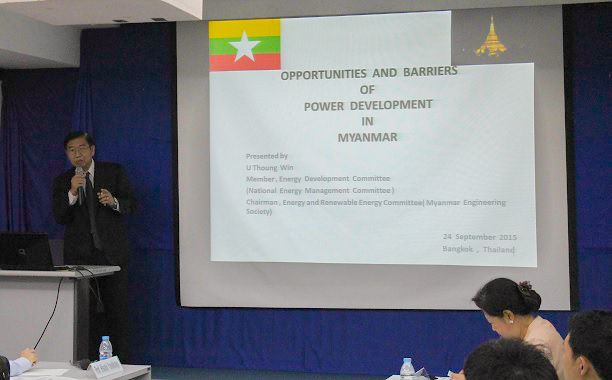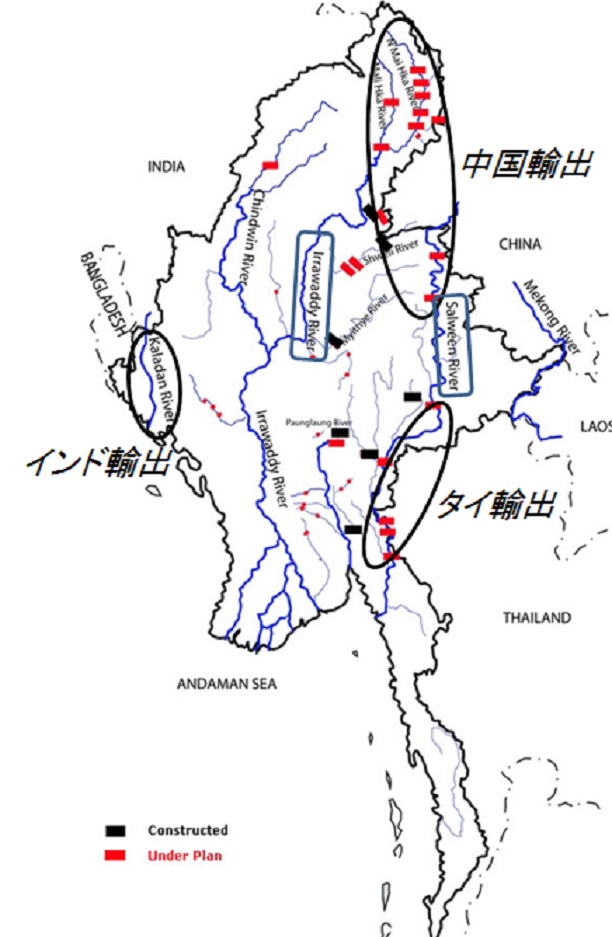The 5th PARI-ERI Joint Workshop Detailed Report
November 27, 2015

Colonel Thoung Win (Myanmar Engineering Society;National Energy Development Committee)
ASEAN Energy Connectivity:
Opportunities and Barriers of Power Development in Myanmar
| [Date] | Thursday, September 24, 9:30-14:00 |
|---|---|
| [Venue] | Energy Research Institute (ERI), Chulalongkorn University, Bangkok |
| [Co-hosted by] | Energy Research Institute (ERI), Chulalongkorn University Policy Alternatives Research Institute (PARI), the University of Tokyo |
| [Supported by] | Economic Research Institute for ASEAN and East Asia (ERIA) |
See the Flash Report and Presentation Slides here
At the end of 2015, the ASEAN Economic Community (AEC) will be established. It is expected to develop the regional economy further through the freer flow of people, goods and money in the ASEAN region. In particular, attention has focused on “Thailand + 1” as one of the drivers in the continental ASEAN: the Mekong region. In response to the recent changes in Thailand’s business environment such as continuously soaring wages and strict environmental restrictions, the expansion of business from Thailand to adjoining nations is accelerating.
However, it would be fair to say the development of Myanmar has not been as smooth as had been anticipated. One bottleneck has been the unstable supply of energy, electric power in particular. For example, at this point, no solutions to problems in establishing the Public Private Partnership (PPP) or forming international institutions (between the Government of Myanmar and Thailand or Japan) etc., which are required to attract Foreign Direct Investment (FDI), has been implemented.
So on September 24, 2015, Energy Research Institute (ERI) of Chulalongkorn University and the Policy Alternatives Research Institute (PARI) of the University of Tokyo jointly held the Myanmar Energy Seminar supported by the Economic Research Institute for ASEAN and East Asia (ERIA) and invited Colonel Thoung Win (Myanmar Engineering Society) to deliver keynote speech at the seminar. Colonel Thoung Win is also a member of the National Energy Development Committee. After a greeting given by Dr. Dawan Wiwattanadate, Director of ERI, Project Professor Hisashi Yoshikawa (PARI) explained the background and purpose of this event followed by the keynote speech by Colonel Thoung Win on electric power development. Comments were made by following energy experts; Prof. Siaw Kiang Chou, Executive Director, National University of Singapore (NUS), Dr. Sanjayan Velautham, Executive Director, ASEAN Centre for Energy (ACE) and Dr. Anbumozhi Venkatachalam, Senior Energy Economist, Economic Research Institute for ASEAN and East Asia (ERIA). The event concluded with a lively free discussion by about 30 stakeholders including a number of Thai businesses in this field.
Keynote speech: Opportunities and Barriers of Power Development in Myanmar
In the keynote speech, Colonel Thoung Win gave a comprehensive explanation of 1) state of present energy use, 2) governance reform, 3) electric power development plan, 4) directions of electric power transactions, and 5) Independent Power Producers (IPP). Regarding the first topic, the state of present energy use, more than 70% of primary energy depends on biomass, followed by gas and oil at 10% (Fig. 1). This dependency on biomass presumably reflects the present state of the country, where approximately 36 million people of the total population of 54 million live in farming towns1 . As for the secondary energy, about 70% is hydro power and about 20% is natural gas (Fig. 2).

| Figure 1. Primary energy mix | Figure 2. Secondary energy mix |
(Source: Prepared from keynote speech document)
The second topic, governance reform, has been actively carried out since the change to civilian government in 2011. In Myanmar, energy related administration is shared by 8 or 9 energy related ministries and agencies such as the Ministry of Electric Power and Ministry of Energy. A harmful effect of its vertically compartmentalized administration has delayed the resolution of even high priority challenges: the development of energy resources including renewable energy, overcoming low electrification rate and poor energy access, and promoting energy conservation mainly by industry. So the National Energy Management Committee (NEMC), committee of ministers of energy related ministries and agencies, was established in January 2013, and related committees were annexed to it to support its activities. The purpose of these committees is to resolve challenges more efficiently by organically integrating plans and policies previously dispersed among concerned ministries and agencies.
Thirdly, electric power development plan (PDP) was prepared. PDP assumed annual 15% growth in demand until 2016 followed by annual growth of 13% premised on an electrification rate of 80% in 2030. In response to such an increase in demand, plans for development until 2016 are centered on gas-fueled electric power generation, and for development after2017, comes mainly from hydro power. While gas-fueled electric power generation is expected to be done mainly by IPP in China, leadership of hydro power generation is scheduled to be taken over by IPP from the Ministry of Electric Power (MoEP) after 2017. Also, a plan to increase coal (about 2,000MW) and wind power (about 1,200MW), to a certain extent, by 2020 is attracting interest.
Regarding the fourth topic, electric power transactions, expectations of hydro power, which can be counted on to be a large-scale economic factor, are high. Myanmar, which possesses rich hydro power potential, is counting on full development for earning foreign currency in the future through the sale of hydro power to China, Thailand, and India (Fig. 3). Electric power to be exported to China will be obtained by developing dams on the Irrawaddy River and Salween River. In 2015, electric power exporting to China has already begun as a result of dam development on the Shweli River, which is a tributary of the Irrawaddy River. Electric power will also be exported to Thailand through the development on the Salween River. It is also reported that although on a smaller scale than China and Thailand, the export of electric power to India from dams developed on the Kaladan River near the India-Myanmar Border is planned.

Figure 3. Outline of regions where electric power is developed for export
(Source: Prepared by author based on EU Myanmar Center, )
The fifth topic, IPP will presumably increase investment opportunities particularly in the medium to long term2 . Nevertheless, it will probably be necessary to pay close attention to the following points among past IPP practices:
1) When foreign capital and Myanmar capital are jointly invested, the minimum foreign currency share is 30%.
2) The MoEP enjoys Free Share (free allotment) between 10% and 15% and Free Power.
3) A Power Purchase Agreement (PPA) entered into between the MoEP and an IPP is renewed annually.
On the other hand, the following barriers hinder IPP investment:
1) Inadequate legal controls on the introduction of foreign investment and a lack of long-term or cross-governmental agency type foreign investment introduction plans.
2) The problem of privatization of public electric power companies and improvement of their financial status.
3) Reduction of energy / electricity subsidies and staged increase of electric power fees.
Integrated energy strategy: required international links
The discussion principally led by the panelists covered a wide range of issue based on the keynote speech. Major points are summarized as follows: What Myanmar needs in the future is an integrated energy strategy based on a long-term perspective. Needless to say, in this strategy, ending energy poverty in particular will be a priority item3 . To resolve the problem, it will be necessary to establish a small scale electric power production with assured capital procurement schemes such as micro-finance. In addition, in order to expand the national power grid and to carry out large-scale power production, an effective foreign-capital attraction strategy will also be essential. To do this, it will be necessary to improve the bankability of each project, and in this context, the Government of Myanmar will be required to make a greater commitment than in the past.
Nevertheless, care should be taken to ensure that the integrated energy strategy not only stimulates economic growth, but also achieves the difficult goal of balancing “3Es -Energy, Economy and Environment-”. For example, it will likely be necessary to do more to find the best energy mix including renewable energies in order to not only lower electric power production costs, but also to contribute to energy security. It is also vital that the social and environmental impacts of each project be strictly controlled by enforcing environmental impact assessments. And improving energy productivity by saving energy in industrial fields will also contribute to improvement of this balance. As it is widely known, since 3Es tend to become a trade-off relationship, many countries have difficulty in balancing each E. Thus, it should be emphasized that Myanmar has latecomer’s advantage in learning the formation of comprehensive and robust energy policy of best practices from ASEAN countries.
In this regard, both Thailand and Japan will be able to contribute to Myanmar by informing it of both countries’ own experiences. To improve the future effectiveness of the strategy, at this point it would be important 1) to improve policy implementation capability by human resource development, 2) to provide reliable statistical information, and 3) to lower the risk of investors through support by preparing related laws. Large-scale electric power resource development including IPPs will likely become more of a reality. It is not clear how, after the general election, the new administration will draw the middle to long-term roadmap to reach these goals. At the next workshop that is scheduled for March, we want to deepen the discussions focused on “the new administration’s energy and power resource development policies”, “future foreign capital introduction opportunity trends”, and “best approaches to support personnel training and statistical and legal measures.”
Footnotes
- It is noted that biomass electric power generation and bio fuels have not penetrated on a large scale even though 70% of total energy is produced from biomass. This value only reflects the pre-modern energy use of people in farming towns (mainly using manure, agricultural residue, and firewood in furnaces), who are approximately 70% of the population
- In the short term, IPP investment may be difficult. There are many challenges that will be difficult to overcome. Examples are “problem of credit of off-takers”, “racial harmony in dam site regions”, “Demand for consideration of the environment and society from civil society”. These challenges were discussed at the ERI-PARI Joint Workshop. For a report on the previous (4th) Workshop, see the following URL. /eng/event/smp150224_rep.html
- Under a contract from ERIA, PARI will also continue research with priority on Energy Poverty. For related contents, see the following URL. /eng/unit/gepea_rep2013.html


